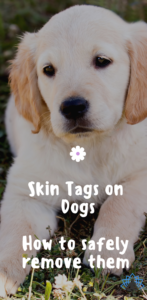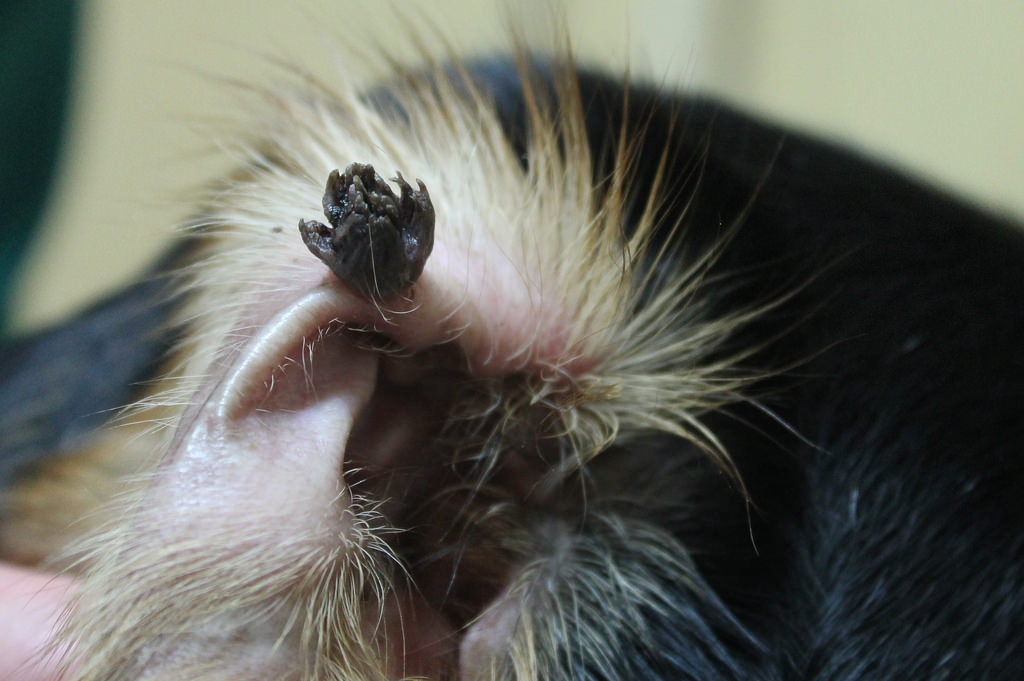Skin tags on dogs too?! They even affect (wo)man’s best friend. Just like with humans, one day you might come across something new, attached to your dog’s skin. Something similar to something you may have seen on yourself! A skin tag! These small skin growths are very common on dogs and can be treated from your home or from a professional.
Yes, skin tags on dogs exist.

Skin tags are not just on humans, skin tags are on dogs too. It is just like how skin tags work with us…one day you simply come across a new fleshy friend thats attached to the skin.
Skin tags or medically called acrochordons are a type of skin growth made of tissue. Skin tags are noncancerous, benign tumors. Just like humans, dogs also get skin tags. Also, like humans, they appear as a dog gets older. As unsightly as they are, they are noncancerous and are harmless. Any dog breed can get skin tags, they often appear on dogs as they age. Also similar to humans, skin tags can appear as solo artists or can appear in a group. They grow off the body with a little stalk that is attached to the flat “head” of the skin tag.
Skin tags on dogs are found all over the place…similar to humans, Imagine that!
Skin Tags on Dogs are Found:
- Chest
- Legs
- Armpit Area
- Rear End – Anus
- Head/Face
- Neck
- Torso
- Is there any part left?
Thankfully, these ugly and hideous little skin growths do not cause our furry friend any pain. They may be ugly to look at, but your dog is not in any pain if its a skin tag.
Yes…If it is a skin tag. If it is a skin tag, it is a minor problem. You might be advised by your vet to simply keep an eye on it. To monitor it in a sense – looking for any signs of growth, tenderness, or bleeding. Or your doctor might request to biopsy the skin tag to determine if it is a skin tag or if it could be something cancerous.
Either way – if you are uncertain about what the skin growth is on your dog, or it is bothering your dog in any way, it is best to see a vet for their medical opinion and treatment advice.
To remove skin tags is up to you, it is an optional procedure.
If your vet gives it the okay, they you can simply request to monitor the skin tag. Monitoring for any changes that could be alarming such as change in size, or become painful, or bleed for example. It could also be that the vet wants to remove the skin tag. It is recommended that dog-owners should not try to remove the dog’s skin tags at home with home remedy treatments. They are not safe for dogs and are not recommended for use of dogs. It is best to leave it up to the professionals on this one folks…the vets! If the skin tag is to be removed, please seek professional help by going to the vet’s office. Your dog will thank you for it!
You may be unable to simply leave it alone and let the skin tag live its life on your dog. Most dogs, might try to lick, bite at, and eventually irritate the skin tag. In these situations, it may be best to see a vet and talk about removal options.
How much will the vet charge to remove the skin tag on the dog?
Great question, it might be best to call your vet on this one. Also, you could call around to find the best overall deal. But you’re going to the vet…and its surgery so its not going to be
cheap. It also depends on the complexity of the surgery and surgery duration. It all varies – so again call your vet and see what they can offer you.
If you do decide to remove the dog’s skin tag with surgery at your vet’s office, after care is very important. Your dog will want to lick, chew, or mess with the area – so to prevent any infection, it is best to get the cone of shame. This will keep your pup safe. They are called an elizabethan collar and will keep your dog from licking the area. Now that is one happy pup after surgery!
Is this a skin tag, a wart, or an engorged tick on my dog?
It is important to know the difference between a wart and an engorged tick, when you are dealing with skin tags.
Skin Tags Vs. Warts
Skin tags are often mistaken for warts. Common misconception, they are a growth…but they are not the same thing. Warts, or medically known as viral papilloma, are another skin growth dogs also get. Unlike skin tags however, warts are contagious. They are not contagious for people, but they are contagious for other dogs. Frequently, young dogs have warts that have been around other dogs.
Dogs can get warts everywhere:
- In the mouth
- On the lips
- On the eyes and eyelids
- In the genital area
- On the paws
 Warts have their own appearance, so they do look a bit different than skin tags. Skin tags are usually thin, flat in appearance, and have a small stalk attached to the the skin. It almost looks as if the skin tag is hanging off the skin.
Warts have their own appearance, so they do look a bit different than skin tags. Skin tags are usually thin, flat in appearance, and have a small stalk attached to the the skin. It almost looks as if the skin tag is hanging off the skin.
Warts are cauliflower like in appearance, they are jagged and rough in appearance and touch. They look ugly, bumpy, rough looking skin growth. Sometimes however, skin tags might be rough and bumpy in appearance too. Skin tags that look this way are mistaken for warts. Seek out the vet with determining diagnosis and treatment of a skin growth.
Skin Tags Vs. Ticks
Perhaps you recently went camping, hiking through brush or trail, or some kind of outdoorsy activity, and a tick found its way home on your pet. Scary & gross but don’t freak out. If you are uncertain of what it is, don’t touch it and if you do plan to touch it, put on gloves of some kind to protect your hands. There are many tick borne illnesses and diseases, caution is important.
With a magnifying glass, examine the engorged tick. It should look like an corn kernel. Looking closer, if you see legs wiggling about and a tiny head attached to the skin, well you have yourself a tick. If there are no legs or tiny head, then chances are that is a skin growth and should be reviewed by your vet.
To remove the tick:
- You are still wearing those gloves that you put on earlier, keep those on!
- Grab the tick as close to the dog’s skin as possible – grabbing the head of the tick
- Pull upwards!
- It’s important to remove the tick’s head along with the body
DO NOT use fire, matches, cigar/cigarette butts, nail polish, or similar on the dog. This could hurt the dog, causing serious harm and aggravation to its skin. Plus these may cause the tick to secret certain fluids into the dogs skin which may increase the risk for disease. DO NOT hurt your dog trying to remove the tick on your own.
If you are uncertain, you can always see your vet for medical advice. It is never a bad idea to be cautious when dealing with our furry friends.
Humans and dogs home remedy treatments are different. Do not try human home remedy treatments on animals. Some treatments are Toxic are animals.
If you are ready to get serious about your own skin tag removal, there are some effective and fast removal treatments for humans. Learn How To Get Rid Of Skin Tags Now!
***This is not medical advice, see a medical professional before implementing any treatments or diagnosis***


